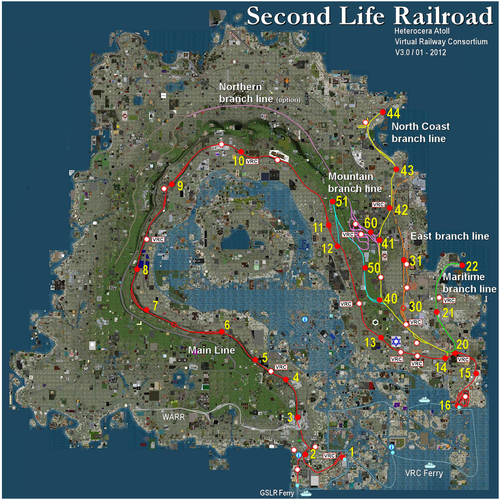Second Life Railroad
| Help Portal: |
Avatar | Bug Fixes | Communication | Community | Glossary | Land & Sim | Multimedia | Navigation | Object | Video Tutorials | Viewer | Wiki | Misc |
| Note! | |
|
As with all wiki.secondlife pages that are not LL Official pages, this article is open to edit as and when a resident feels it is appropriate (see Editing Guidelines). If however you simply wish to ask or make a suggestion about or discuss the railroad or the content of this article, please use the Talk page. The talk page is also where any disputes over proposed page content should be discussed. This Wiki (being a document of an ever changing world) is constantly in need of updating and improvement. If you are aware of information this article should have added/changed please go ahead and do so. If you do not feel confident about editing make the suggestion on the talk page and another contributor may be able to assist. |
Description
This article is a description of the Second Life Railroad ( SLRR ) on the Heterocera Atoll continent. It gives landmark locations to the official Linden railway station as well as station created by residents on private land along the railroad tracks.
SLRR
The Second Life Railroad ( SLRR ) runs over more then 60 Regions on the Heterocera Atoll (Northern) Continent. And there are 20 more Regions that have branch lines being extended out from the Main Line.
Second Life residents can operate trains on the SLRR and other railroads, much as anyone can operate a car on the roads in Second Life. Any Resident may use this public facility for any purpose consistent with the Second Life Community Standards/TOS. Along the railway line there are many stations where you can rez a train to start a journey.
Track-laying and maintenance are provided by the Linden Maintenance group (most often Michael Linden, currently) and the Linden Department of Public works LDPW.
Residents have been using the SLRR since 2005. There are many train builders in SL that make a wide variety of trains using several different methods for locomotion. The current SLRR track standards support all types of trains. Already many Residents have personal trains they use on the SLRR. Using the SLRR with its current standard is simple to understand and accessible to Residents and builders of all skill levels.
The SLRR was originally designed to work under the prevailing conditions in Second Life; standards were not published until recently. Many changes have occurred in Second Life since 2005, and there is work underway to establish formal standards to guide Resident rail content creation for use on the SLRR (and on other networks built to any of the same standards). This work was started on the 18th of August 2010 during a LDPW led Railway Brown Bag meeting with the Rail community.
Standards for guidance, track and SLRR Switches will enable Residents to develop suitable vehicles.
Train builders and other rail networks may use different standards, or only part of these standards. Non-Linden rail networks are encouraged to publish their own standards if these networks allow the public to use them with their own rolling stock.
The standards, as published on these and following pages, are general measurements taken from in-world. However, Linden Lab is committed to adjusting and extending the SLRR in accordance with these standards - Michael Linden.
History
The SLRR dates back to 2005 when Linden Lab created railroad tracks on the 2nd continent they made. On the SLRR history page you can find out more how railroad became what it is to date.
SLRR Stations
Stations with a number are official Linden lab SLRR station.
Stations with a '-' are "points of interest". These are picked at random by the creator of the map, Stryker Jenkins.
You may need to refresh your browser to get the latest image update to show up.
--- Heterocera Main line
- 1 Tuliptree Station🖈
- - VRC HQ Tuliptree🖈
- 2 Calleta "Hobo" Station🖈
- - Train & Rail Museum🖈
- 3 Neumoegen Station🖈
- 4 Achemon Station🖈
- - VRC Station🖈
- 5 Obscure Station🖈
- 6 Epirrhoe Station🖈
- 7 Jubata Station🖈
- 8 Spini Station🖈
- - VRC Athetis Station🖈
- 9 Lunalis Station🖈
- - Tagiri Station🖈
- 10 Foxglove Station🖈
- -- H8 Motors Express🖈
- 11 Clearwing Station🖈
- 12 Crenulate Station🖈
- -- VRC Pini Yard🖈
- 13 Aglia Station🖈
- -- Celerio Station🖈
- -- VRC Velox Station🖈
- 14 Tenera Station🖈
- 15 Zale Station🖈
- 16 Bhaga Station🖈
- -- Urban Getto🖈
--- Maritime branch line
- 17 Vicina Dock🖈
- 18 Dubia Station🖈
- -- Andiana City🖈
- 19 Crumbi Junction🖈
--- North Coast branch line
- 20 Pawpaw Junction🖈
- 21 Tussock railyard🖈
- -- VRC Freight yard🖈
- 22 Malacosoma crossover🖈
- -- VRC Malacosoma station🖈
- 23 Melanthia station🖈
- 24 Spangle station🖈
--- Mountain branch line
--- Northern branch line (option)
Other Railway initiatives
There are several other standard gage railroads in SL, some on private land, some on Linden land. This is list of some other examples of large multi sim networks with different sets of guidance, control and track system. The different systems are not necessarily compatible with SLRR standards.
- GSLR - The Great Second Life Railway Purple right of way Station/Dock🖈
- ONSR - Okemo, Nakiska, and Southern Railway Smithers Bluff Station🖈
- LHRR - Lionheart Continental Railroad LHRR Pumbaa Station🖈
- Caledon National Railway Caledon On Sea Station🖈
- Lackawanna Railroad (New York) Lackawanna Railroad Station🖈
Source
The above information was initially collected by SL Residents from the Virtual Railway Consortium.
Additions have been provided by Jer Straaf and others associated with other SLRR related groups.
Michael Linden provided the official branch line names.

